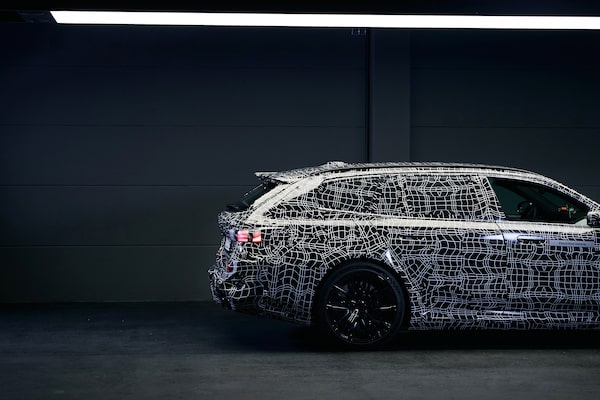The Volvo V90 station wagon. Volvo recently launched another iteration of its sporty V60 Polestar Engineered wagon.Matt Bubbers/The Globe and Mail
It wasn’t always this way, but station wagons have become a European thing, like late-night dinners, a laissez-faire attitude toward underage drinking and not working in August. Here, the vast majority of new-car buyers opt for SUVs and pickups, while the few wagons offered in Canada amount to little more than a rounding error on annual sales charts.
Despite that, wagons just won’t die, and I suspect it’s only because a small group of wagonheads and true believers just won’t let them.
In response to a recent campaign by BMW in Canada, for instance, more than 7,200 station wagon fans signed an online petition to help persuade BMW headquarters in Munich to offer the upcoming M5 Touring wagon in North America. And they hadn’t even seen photos of it. Blind devotion to the cult of station wagons keeps this niche market alive.
Where they were once king of the ‘burbs, wagons today represent a rejection of mainstream American taste. They’re also a luxurious choice, and a little bit of a snobby one. (You couldn’t just buy an SUV like everyone else?) They’re the vehicular equivalent of an indie thriller, where SUVs are like Marvel superhero movies – all kind of the same. Every car critic I know has a soft spot for wagons. Fans of these vehicles have the same kind of unending devotion as fans of cult-favourite musicians. Wagons are the Captain Beefheart or Daniel Johnston of cars. Or, maybe I’m giving wagonheads too much credit. Maybe some people always want what they can’t have, and so they pine for the oddball wagons Europeans take for granted.
“Whatever the reason is, it’s been a non-stop trickle of hyperinterest [in wagons] from a niche group of Canadians over my 15 years in this business,” said Jonathan Thomson, director of brand management for BMW Group Canada. “[Wagons] just have this cult following in North America, and specifically Canada, that’s almost inexplicable.”
The customers who come into Toronto’s Volvo Metro West dealership looking to buy a V60 or V90 wagon know what they want. “They’re dedicated buyers, specific to the brand, coming to see us for that vehicle,” said Jorge Stathos, who handles fleet corporate sales at Volvo Metro West. Some of his wagon clients are wealthy, too; their long-roof Volvo might share garage space with a supercar.
The market for used wagons is hot, Stathos added. “I don’t care if it has half a million kilometres on it, there’s going to be a lineup of people here. I’m telling you, it’s just insane,” he said.
Still, even at Volvo, station wagons are not big sellers. “The Volvo V60 has been a stalwart – steadily selling between 500 to 1,000 units a year,” according to Andrew King, managing partner at DesRosiers Automotive Consultants.
The best-selling wagon in recent memory was the Hyundai Elantra Touring, which topped 10,000 sales in both 2010 and 2011, King wrote in an e-mail. More recently, the now-discontinued Volkswagen Golf Sportwagon sold about 5,000 units a year in 2017 and 2018. To put that in perspective, Toyota sold nearly 75,000 RAV4 SUVs in Canada last year.
King is personally a station wagon fan, though. ”If only the automotive world had moved to wagons instead of SUVs, we would all be happier,” he wrote in an e-mail.
Amen.
Given the lower height of their grilles and hoods, wagons are less likely to kill or severely injure pedestrians in a crash compared with trucks and SUVs. Traditionally, wagons also feel more agile than SUVs and more fun to drive. (Although that’s less true today with technology like all-wheel steering and active anti-roll bars that can make big, heavy cars handle better than ever.)
Some wagons – Subaru’s Outback, Volvo’s V90 Cross Country, Audi’s A4 Allroad and the Mercedes E-Class All-Terrain – have also become more like SUVs, with jacked-up suspension and plastic body cladding in order to survive.
It wasn’t always like this. In the 1950s and 60s American car brands sold a vast array of different wagon models. They were family-friendly, sometimes luxuriously appointed and often available with a gargantuan V8 engine.
So what nearly killed wagons in North America? Loopholes in U.S. fuel economy regulations – loopholes the auto industry lobbied for – set less aggressive fuel-economy targets for SUVs and light trucks, thereby incentivizing automakers to move away from cars, hatchbacks and station wagons toward larger, more profitable, more gas-guzzling models. Ford no longer sells any sedans (let alone wagons) in North America.
Personally, BMW Canada’s Jonathan Thomson thinks wagons just became less exciting. Their image changed in the 1970s and 80s, he said. “I think what started happening is mass-market wagons stopped becoming so stylized, sporting and aspirational, and became very pedestrian, clinical and utilitarian,” he said.
But now it appears the pendulum is swinging back again.
Before BMW with its upcoming M5 Touring, it was Audi with the stupendously rapid RS 6 Avant. It was intended as a rival to Mercedes-AMG’s long-running E 63 S wagon. Volvo recently launched another iteration of its sporty V60 Polestar Engineered wagon. Cadillac’s 2011 CTS-V wagon is already a collectible, alongside the Audi RS 2 Avant, Subaru Legacy 2.5GT, Volvo V70 R and so many other cult classics.
Still, car companies and wagonheads refuse to let these long-roofed wonders die, and thank heavens. Wagons are a rare bit of low-key weirdness in a global industry that seems hellbent on homogeneity.
Days after I spoke to Thomson, BMW announced that the 2025 M5 Touring would indeed be coming to Canada and the United States for the first time. The wagonheads won.

A teaser image of the BMW M5 Touring, which BMW announced will be coming to Canada for the first time.Fabian Kirchbauer/Courtesy of manufacturer
Shopping for a new car? Check out the new Globe Drive Build and Price Tool to see the latest discounts, rebates and rates on new cars, trucks and SUVs. Click here to get your price.
 Matt Bubbers
Matt Bubbers